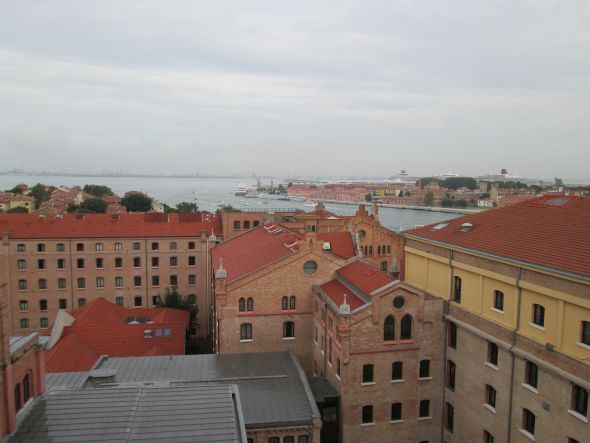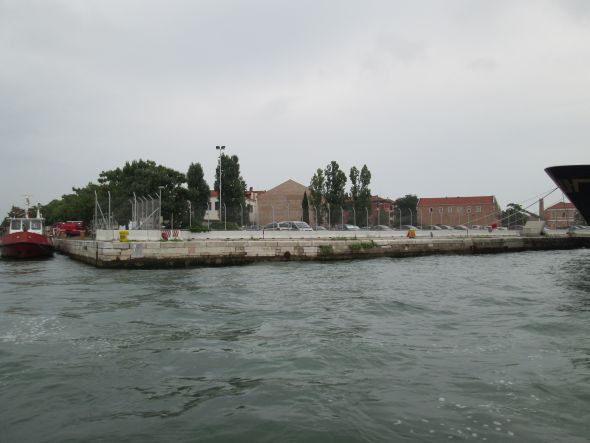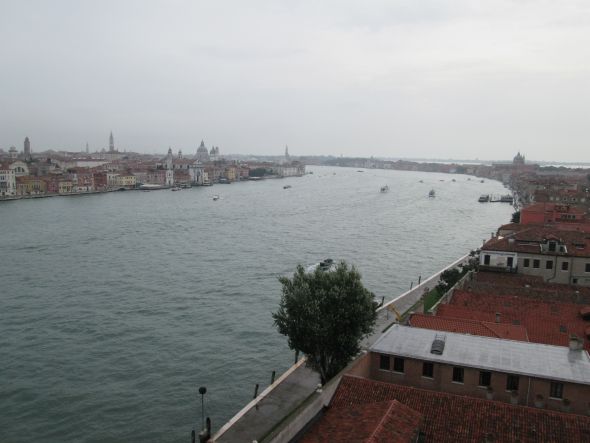
July 29, as all the world knows, is the feast day of Santa Marta. Or in any case, now the world knows.
She is essentially forgotten here; her church has been deconsecrated, swallowed and partially digested by the Maritime Zone, and her celebration — once one of the greatest of the many great festivals here — is gone forever. Only a painting by Canaletto brings us the tiniest (and darkest) glimpse of what was once a very big night in Venice. Her name today is used mainly to refer to the adjacent neighborhood.
The reason I didn’t get this post finished by July 29 is because I got lost reading assorted accounts, some of them first-hand, about this uber-fest. It didn’t take me long to conclude that the fabled feast of the Redentore, which has remained a very big deal, was really nothing so remarkable compared to Santa Marta’s. The Redentore had fireworks, it’s true, but Marta had fresh sole.
Fish was an excuse for a colossal boating party? Why not? The Venetian civil and religious calendar was bursting with events of every type and voltage. A very short list would note the festivals of Santa Maria della Carita’, Palm Sunday, S. Stefano, “Fat Thursday,” May 1, or the Doge’s Visit to the Monastery of the Virgins, S. Isidoro, the taking of Constantinople (1204), the regaining of Candia (1204), S. John the Baptist “Beheaded,” Sunday after Ascension Day, the victory over Padua (1214), the defense of Scutari (1479), the victory of Lepanto (1571), S. Rocco, Corpus Domini, the victory of the Dardanelles (1656), and the conquest of the Morea (1687). These are just a few of the major events; the Venetians also commemorated defeats. There was something going on almost every day.
But there was always room for more, and although Santa Marta couldn’t claim to have sponsored any particular victory, discovery, or other noteworthy occurrence, her feast day conveniently fell in the period when the weather was suffocatingly hot, and the sole were in season. Plus, her church was located on a little lobe of land facing lots of water, and there was a beach. All this says “Put on your red dress, baby, ’cause we goin’ out tonight” to me.
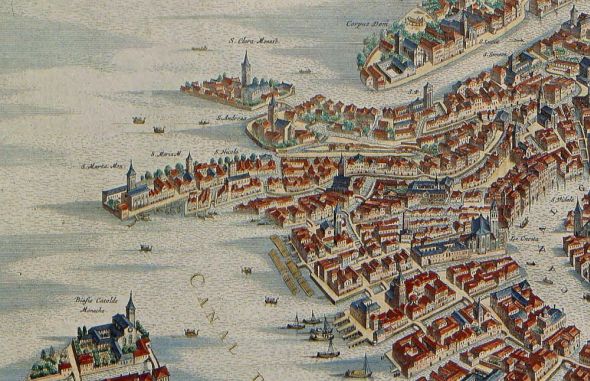
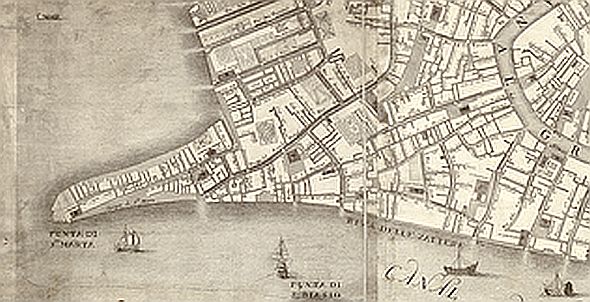
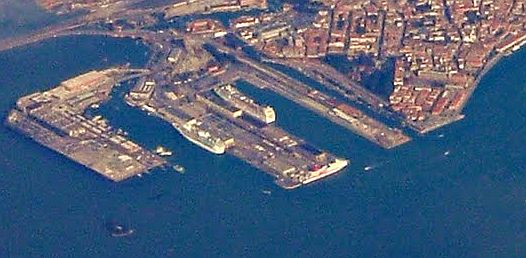
The basic components were: Everybody in Venice, either on land or on the water, regardless of social station or disposable income; every boat in Venice — so many boats you could hardly see the water, festooned with illuminated balloons and carrying improvised little arbors formed by frondy branches; music, song and dance, and lots and lots of fresh sole.

July is the season for sfogi zentili, or Solea vulgaris, and while the Venetians could bring their own vittles, plenty of them also bought the fish which had just been saute’d, either on the beach or on the street by enterprising entrepreneurs. If you were really in luck, there would be moonlight, too.
The best and most famous chronicler of this party was Giustina Renier Michiel, who was born in 1755 and belonged to several patrician Venetian families. She spent 20 years researching her six-volume work, Origine delle Feste Veneziane (1830), but the fact that she had personal memories of many of these events makes her books exceptional.
I started to translate what she wrote about the feast of Santa Marta, but she went on so long, and her style sounded so curious in English, that I became tired and discontented. So I’m going to give some bits and summarize the rest. Anyway, it’s clear that the event was so phenomenal that even people who saw it finally gave up trying to describe it adequately or coherently.
Here is her version of how the festa was born:
“In the old days many groups went out in certain boats to fish for sole, the best fish that one eats in July. (Lino concurs with date and description.)
“And in the evening they would go back to the beach by the church of Santa Marta and feast on the fish, enjoying the cool air that restored their depleted strength after the labor of fishing, as well as the heat of the season.
“Later on, as the population became richer, and softness set in, the work of fishing was left to the poor people, who had to do it in order to live, and what used to be a fatiguing labor changed into a singular entertainment.”
My version: It didn’t take long for everybody else in Venice to say “A cookout on the beach? We’re on our way.” Everybody started making Santa Marta’s Eve a great reason to head for her neighborhood and eat fish, garnished and enlivened by the classic saor sauce of sweet-sour onions. It was like a gigantic clambake, a barbecue, a luau, for thousands and thousands of people.
Obviously the beach was too small for everybody, so the boats made themselves at home on the Giudecca Canal, “whose waters could only be seen in flashes, and almost seemed to be strips of fire, agitated by the oars of so many boats that covered the water and which doubled the effect of the lights which were on the boats.”
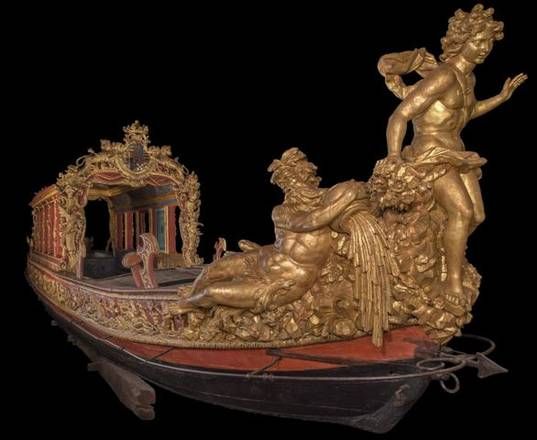
The patricians came out on their fabulously ornate peote, and often carrying musicians who sang and played wind instruments. There were scores of the classic fishing boat called a tartana, draped with variously-colored balloons and loaded with laughing families and friends. There were artisans in their battellos, and hundreds of light little gondolas, and plenty of gondolas da fresco, and there were even the burchielle, the heavy cargo boats that carried sand and lumber. If it could float, it joined the vast confusion of boats being rowed languidly in every direction, or tied up along the Zattere where there was just as much happy turmoil ashore.
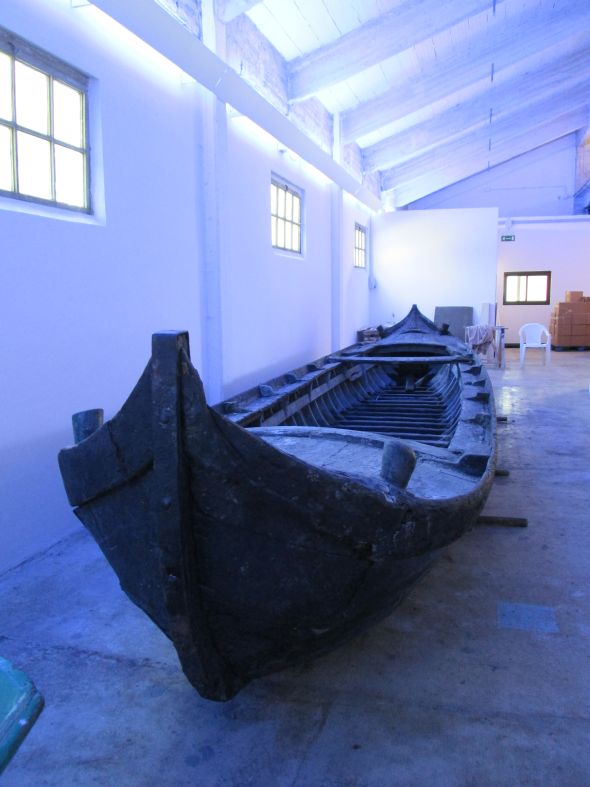
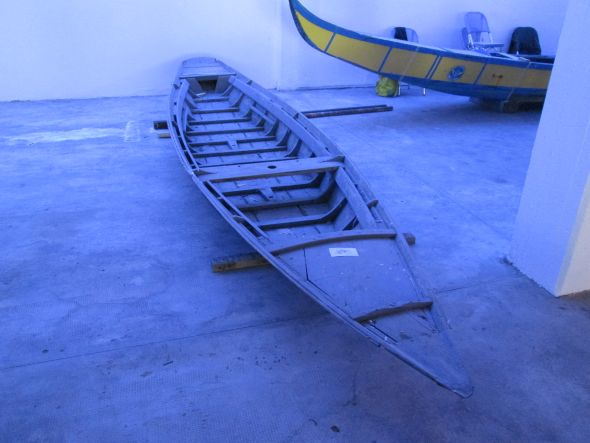
The Gazzetta Urbana of 1787: “Along this riva, called the Zattere, the cafe’s and bars are crammed to overflowing with people. There are tables set up outside their doors, and everything is so lit up that it seems to be daytime.
“The passage (of people) in all the streets leading to Santa Marta was dense and continuous, and the splendid gathering at the Caffe of San Basegio, at the head of the Zattere, formed a separate spectacle, in which our Adriatic beauties, wearing modern shimmering caps in the Greek style, ornamented with plumes, inflamed with their glances the hearts of the young men who, like butterflies, always flutter around the flare of a woman’s beauty.”
Also amid the throng were little ambulatory kitchens — a man with a basket of sole would put two stones on the ground, then lay two bunches of sticks crosswise on them, light a little charcoal under them, pour some oil in a pan, and stand there bawling for business. He kept a container of saor ready to put on the fish.
Renier Michiel: “The entire length of this district was full of a grand concourse of people, moving toward the piazza of Santa Marta which was the best vantage point to enjoy the spectacle. On the piazza there were more food vendors, some of them selling roast chicken. There is a racket of cups, plates, the yells of the vendors, the music from the boats on the water. Every house is transformed into a sort of tavern where people eat and drink, and there was perfect joy and harmony.”
“Perfect joy and harmony”? How can this be (apart from the fact that she was looking back on it, years later, when the festival was gone forever)?
I think it’s because Santa Marta was secretly taking care of people. She is the patroness of cooks, butlers, laundry-workers, servants, housewives, and waiters. Though I suppose you could just say “housewives” and leave it at that.
Because as Santa Marta, and 99 percent of women on earth, can attest, while some people at a party are laughing and scarfing the canapes and playing with the dog and singing comic songs and reveling in industrial-size helpings of joy and harmony, there’s at least one person somewhere in the background doing everything to make it seem as if there is absolutely nothing that needs to be done.
And I have no doubt that when the boats went home at dawn on July 29, there was somebody who had to put the boat away and swab the bilge and pick up every single fishbone, as well as deal with the dishes and the wine- and saor-stained clothes. Behind every great saint is somebody with a bucket and mop, I say.
